Nvidia GeForce RTX 3060 Ti Founders Edition review: Spectacular 1440p gaming
- 02 December, 2020 01:00
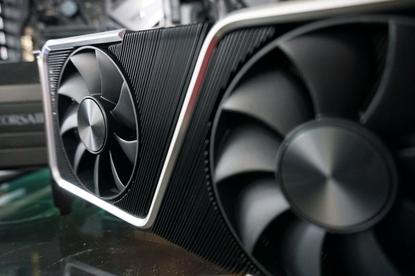
After a high-end shootout between Nvidia and AMD resulted in not one, not two, but six different graphics cards released with sky-high $500+ price tags, the next generation is finally trickling down to more affordable price points with the launch of the GeForce RTX 3060 Ti on December 2. This excellent GPU may actually be the most exciting entry in Nvidia’s RTX 30-series yet.
At $400, the RTX 3060 Ti costs significantly more than the 60- and 70-class GeForce options of yesteryear (anybody remember the $330 GTX 970 and $380 GTX 1070?), continuing a trend we’ve seen in recent graphics card families. But if you can look past the name, you’ll find the GeForce RTX 3060 Ti delivers a lot of value, pumping out frames faster than last generation’s $800 GeForce RTX 2080 Super—the second-fastest graphics card in the world up until a few months ago—for half the price. Yes, that includes ray tracing performance. Nvidia’s latest graphics card soundly rings the death knell for older, similarly priced graphics cards like the Radeon RX 5700-series and the GeForce RTX 2060 Super.
Today, we’re digging into Nvidia’s GeForce RTX 3060 Ti Founders Edition, priced squarely at this GPU’s $400 MSRP. Giddy-up.
GeForce RTX 3060 Ti specs, features, and design
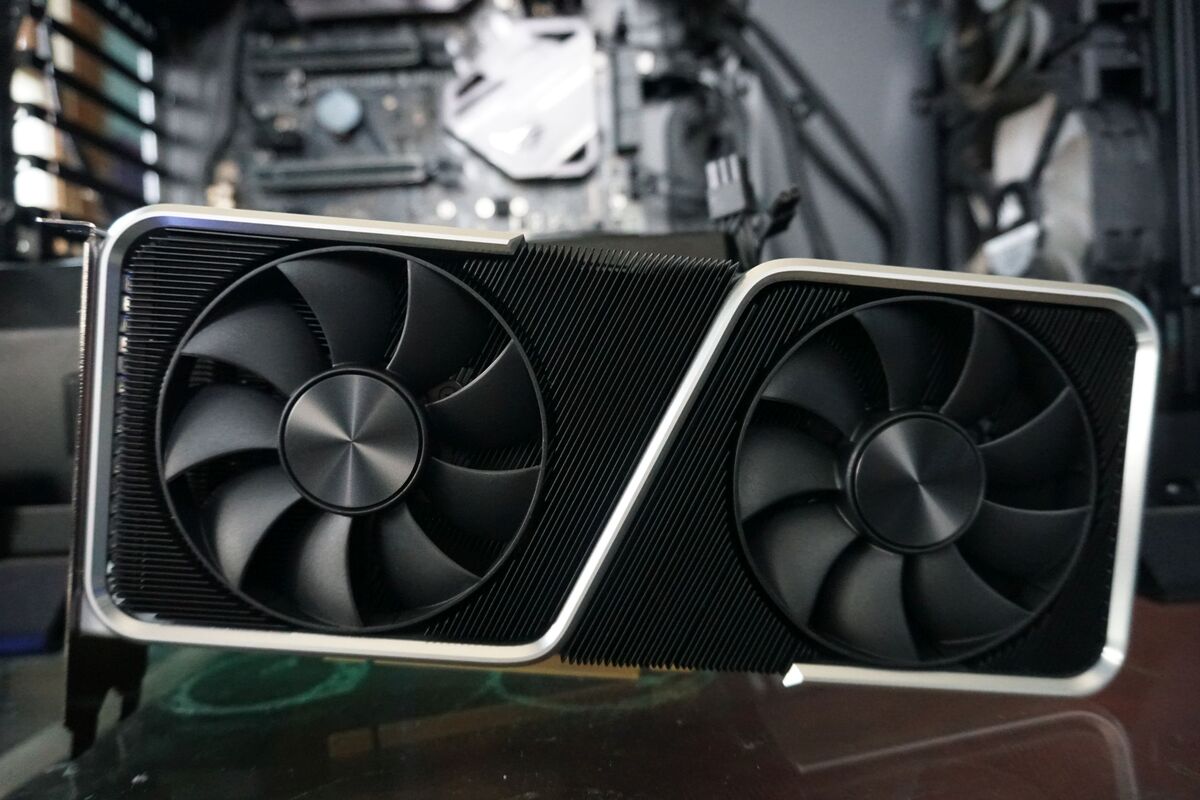 Brad Chacos/IDG
Brad Chacos/IDGUnlike the GeForce RTX 3090, RTX 3080, and RTX 3070 reviews, this one is pretty straightforward. The GeForce RTX 3060 Ti features a cut-down version of the $500 RTX 3070’s “GA104” GPU, based on the company’s new “Ampere” graphics architecture. Nvidia’s more affordable card packs roughly 17 percent fewer simultaneous multiprocessors (SMs), a ratio that carries over to the CUDA cores, RT cores, tensor cores, and texture units found within those SMs. Nvidia also cut down the render output unit (ROP) count by roughly the same margin.
The GeForce RTX 3060 Ti includes the hardware counts shown in the Nvidia-supplied chart below, which compares the new GPU against last generation’s GeForce RTX 2060 Super and the aforementioned 3070. It’s worth noting that the newer RT and tensor cores in the RTX 30-series, paired with the higher raw performance of these GPUs, deliver vastly improved ray tracing performance compared to the 2060 Super, even though the 3060 Ti offers far fewer tensor cores and a similar RT core count. (We dove deeper into Ampere’s ray tracing and DLSS performance in our RTX 3080 review.)
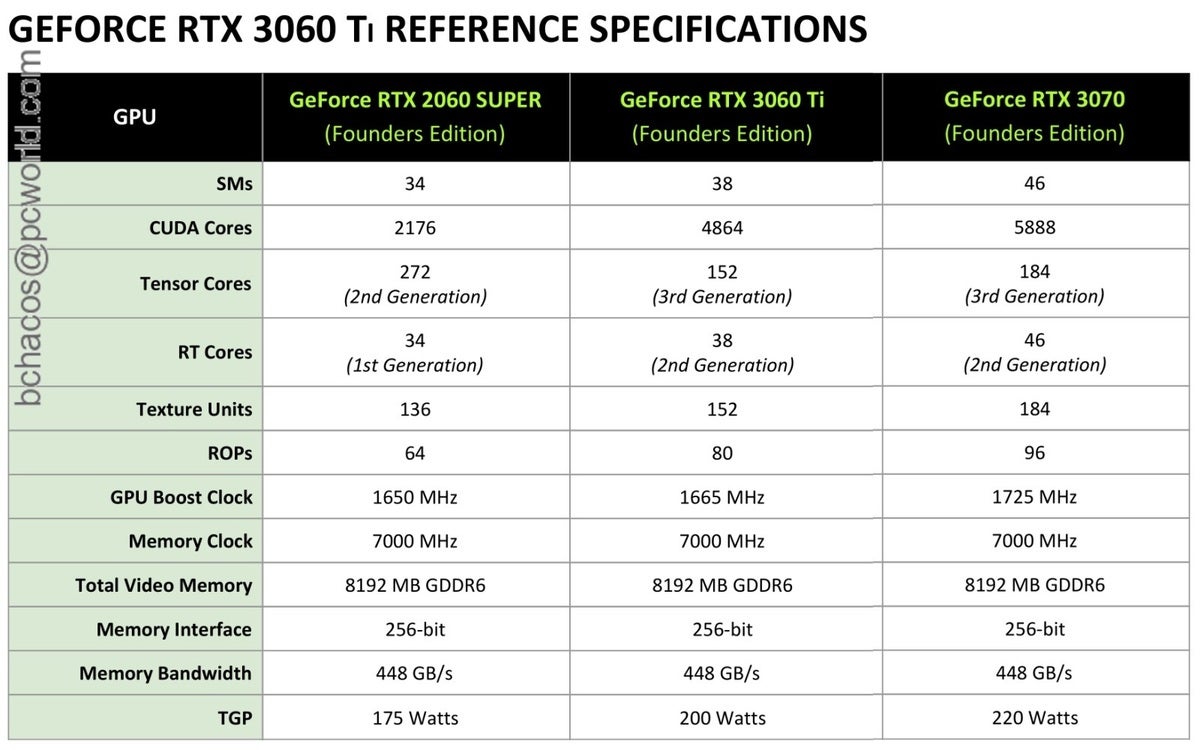 Nvidia
NvidiaThe GeForce RTX 3070 also runs a bit faster, with a 1,725MHz Boost clock speed versus the RTX 3060 Ti’s 1,665MHz rating. In practice, though, all Nvidia cards exceed their rated speeds with help from the GPU Boost feature, which takes your graphics card’s thermals and power into consideration to bump up speeds automatically. Factoring in all the tweaks, the GeForce RTX 3060 Ti consumes slightly less power than its bigger sibling, but yet more power than last-gen’s RTX 2060 Super, splitting the difference with a 200-watt rating. That reveals Ampere’s improved efficiency, however, as the RTX 2080 Super that this GPU outguns was rated for 250W.
Nvidia carried the full memory configuration of the RTX 3070 down to the RTX 3060 Ti, equipping the new GPU with 8GB of GDDR6 memory across a 256-bit bus, for a total memory bandwidth of 448GB/s. That’s a fine amount for the 1440p gaming this graphics card targets, and a smart move by Nvidia as rival Radeon RX 6000-series cards look poised to increase raw capacity while leveraging their innovative Infinity Cache throughout AMD’s entire lineup. The non-Super RTX 2060 launched in 2018 with 6GB of GDDR6 memory, but that more limited amount probably won’t hold up well as modern games become more strenuous, especially when ray tracing is active.
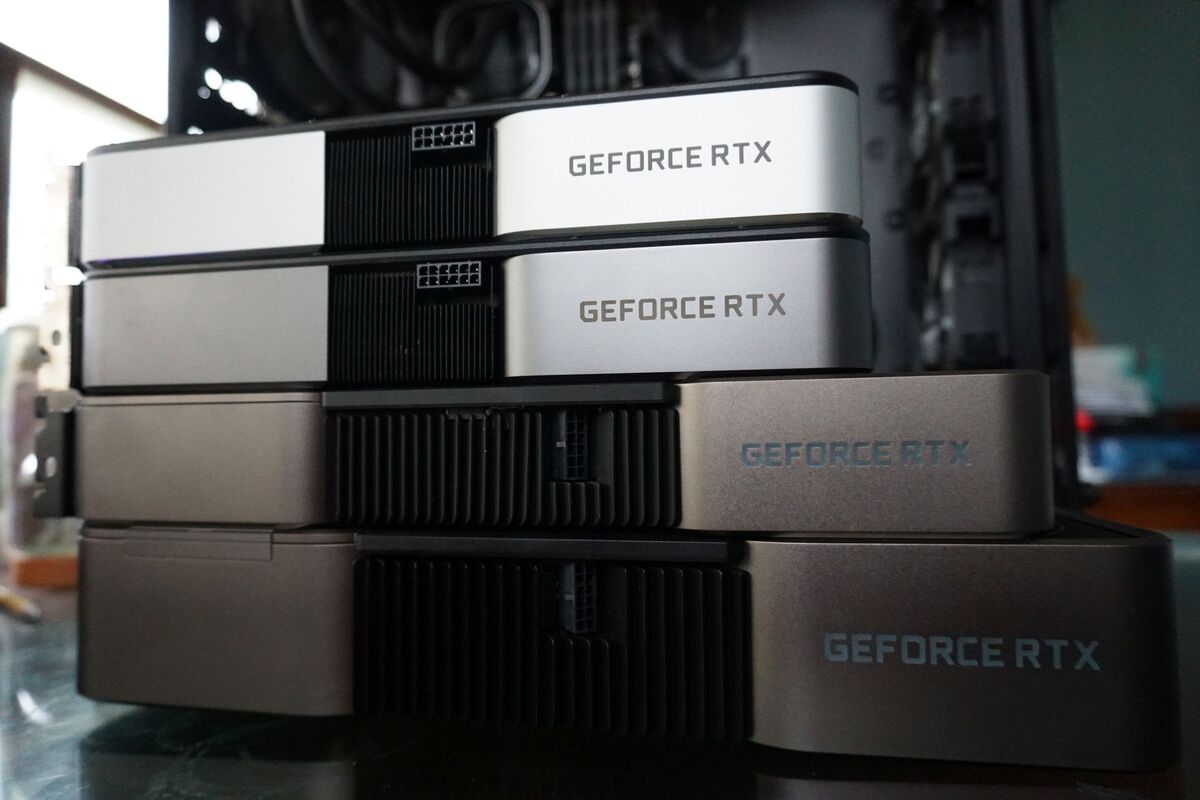 Brad Chacos/IDG
Brad Chacos/IDG
Nvidia’s current GeForce RTX 30-series Founders Edition product stack. (Hey-o!) From top: RTX 3060 Ti, 3070, 3080, 3090.
Design-wise, the GeForce RTX 3060 Ti Founders Edition mirrors Nvidia’s RTX 3070 FE, but its outer shroud is a lighter shade of silver, as opposed to the more gunmetal-like sheen of the higher-end models. That means it’s a standard 2-slot, 9.5-inch size, and much smaller than the Founders Edition coolers found on Nvidia’s higher-end RTX 3080 and 3090. Here’s how we described the RTX 3070 FE’s cooler:
“The Founders Edition model we’re reviewing today still uses Nvidia’s tiny, highly customized PCB with a notch taken out of it to help with airflow. This means that like the other FE cards revealed so far, it powers on via a proprietary 12-pin connector. Nvidia includes an (ugly, short) adapter in the box. Unlike the more powerful RTX 30-series Founders Edition cards, however, the 12-pin connector is located horizontally in the middle of the edge of the card, rather than positioned vertically and at a 45-degree angle. If your case’s power supply shroud has a cutout for wires underneath your GPU, this is a much better placement.”
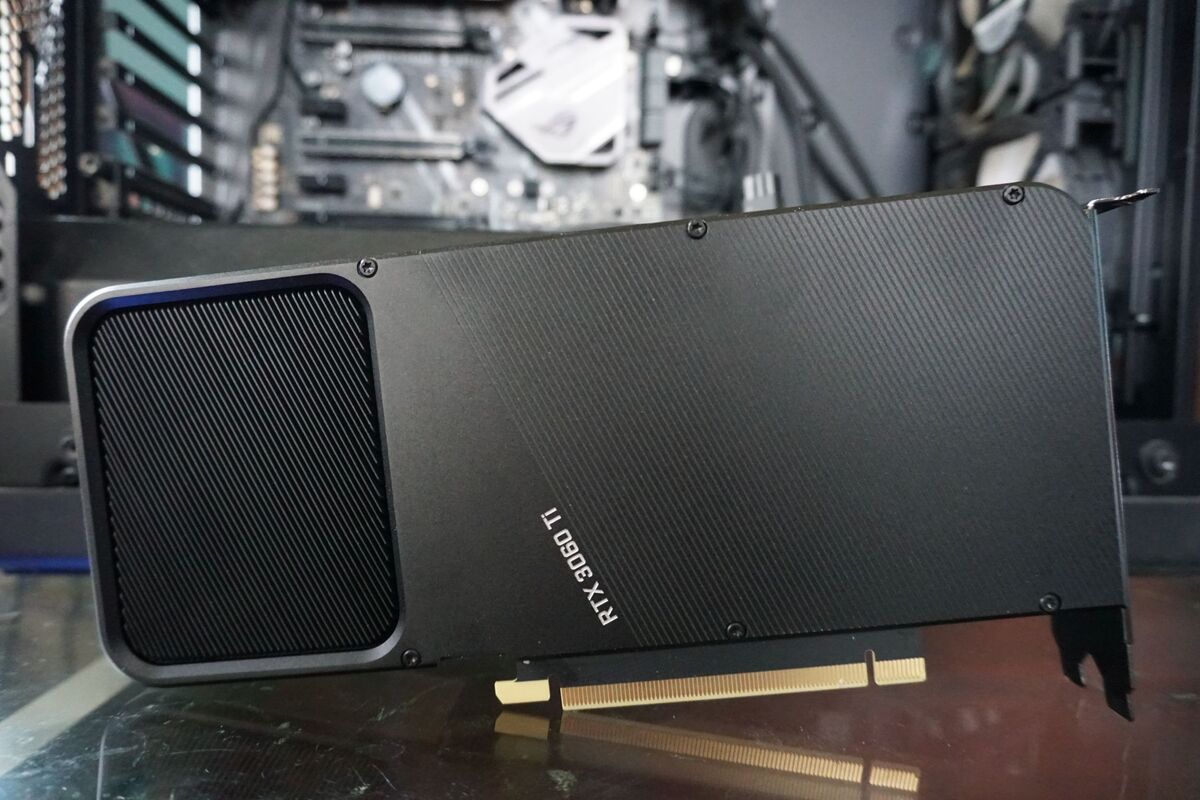 Brad Chacos/IDG
Brad Chacos/IDG“That’s not the only design change. Nvidia created a highly unique custom ‘flow-through’ cooling solution for the RTX 3080 and RTX 3090, with independent push-pull fans and bristling, thick metal heat fins comprising the body of the card itself. It’s very effective.
The GeForce RTX 3070 [and 3060 Ti—Ed.] changes things up a wee bit. Rather than having one fan on the top and the bottom of the card in a push-pull configuration, the RTX 3070 FE places both fans in their standard places in the face of the card and adds a sleek backplate to the top. The two fans pushes air through the heatsink; the blower-style fan at the rear of the card expels heat through the I/O bracket, while the other one sends the hot air through a cut-out in the backplate back into the top of your system, where it can be sucked out by your case’s rear outtake fan. It’s functionally the same idea as the cooler on the more powerful RTX 30-series cards, but it takes a different path to get there.”
 Brad Chacos/IDG
Brad Chacos/IDG
Port report
Nvidia kept the display outputs the same as well, with three DisplayPort 1.4 connections and a single HDMI 2.1 port capable of 144Hz 4K or 8K60 video output over a single cable, along with AV1 decode support for watching 8K videos without stutter or dropping frames. Rival Radeon RX 6000-series graphics cards match that loadout, but swap one of the DisplayPorts for USB-C. The custom PCB inside the 3060 Ti isn’t quite as exotic as the V-notched version found in the RTX 3080 and 3090, but it remains much shorter than typical.
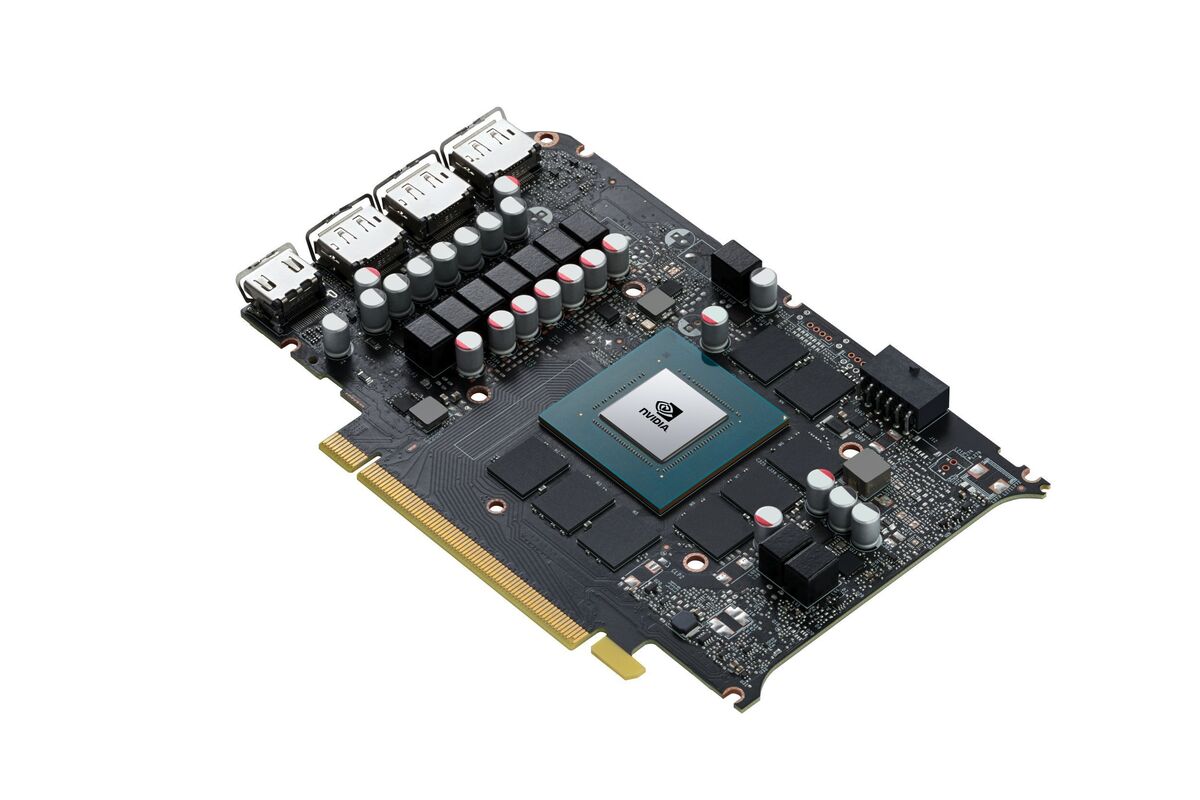 Nvidia
NvidiaOf course, the GeForce RTX 3060 Ti supports all Nvidia’s extensive software features, some of which are truly killer apps for specific uses. Streamers will appreciate the best-in-class NVENC GPU encoder and the AI-enhanced Nvidia Broadcast suite, esports competitors will dig the Nvidia Reflex suite, and content creators swear by CUDA and Optix optimizations in prosumer apps. The graphics card comes equipped with a cutting-edge PCIe 4.0 connection (though only modern Ryzen platforms support it right now). The card will also support RTX I/O, an upcoming technology built upon Microsoft’s DirectStorage API that allows your GPU and NVMe SSD to talk directly, obliterating game-loading times on the PC.
Finally, it’s worth noting that Nvidia’s more mature ray tracing technology outperforms the first-gen implementation in AMD’s rival Radeon RX 6000-series graphics cards. It also gets a huge shot in the arm with Nvidia’s Deep Learning Super Sampling (DLSS) feature, which helps regain frames lost to ray tracing’s heavy impact. AMD has no answer for it yet. If you want the best ray tracing graphics cards, Team Green is a no-brainer.
Got it? Good. Let’s get gaming.
Next page: Our test system, gaming benchmarks begin
Page Break
Our test system
Our dedicated graphics card test system is a couple of years old, but it's packed with some of the fastest complementary components available to put any potential performance bottlenecks squarely on the GPU, especially at the higher resolution these graphics cards target. Most of the hardware was provided by the manufacturers, but we purchased the cooler and storage ourselves.
- Intel Core i7-8700K processor ($300 on Amazon) overclocked to 5GHz all cores
- EVGA CLC 240 closed-loop liquid cooler ($105 on Amazon)
- Asus Maximus X Hero motherboard
- 64GB HyperX Predator RGB DDR4/2933 ($355 on Amazon)
- EVGA 1200W SuperNova P2 power supply ($352 on Amazon)
- Corsair Crystal 570X RGB case, with front and top panels removed and an extra rear fan installed for improved airflow
- 2x 500GB Samsung 860 EVO SSDs ($70 each on Amazon)
We’re comparing the $400 GeForce RTX 3060 Ti Founders Edition against Nvidia’s Founders Edition models of the $500 GeForce RTX 3070 and last-generation’s $350 RTX 2060, $500 RTX 2070, and $800 2080 Super. We opted to include the 2080 Super over the non-Super version, as this is the card Nvidia compares against the RTX 3060 Ti. We’ve also included benchmarks for AMD’s new $580 Radeon RX 6800 and last-gen $400 Radeon RX 5700 XT.
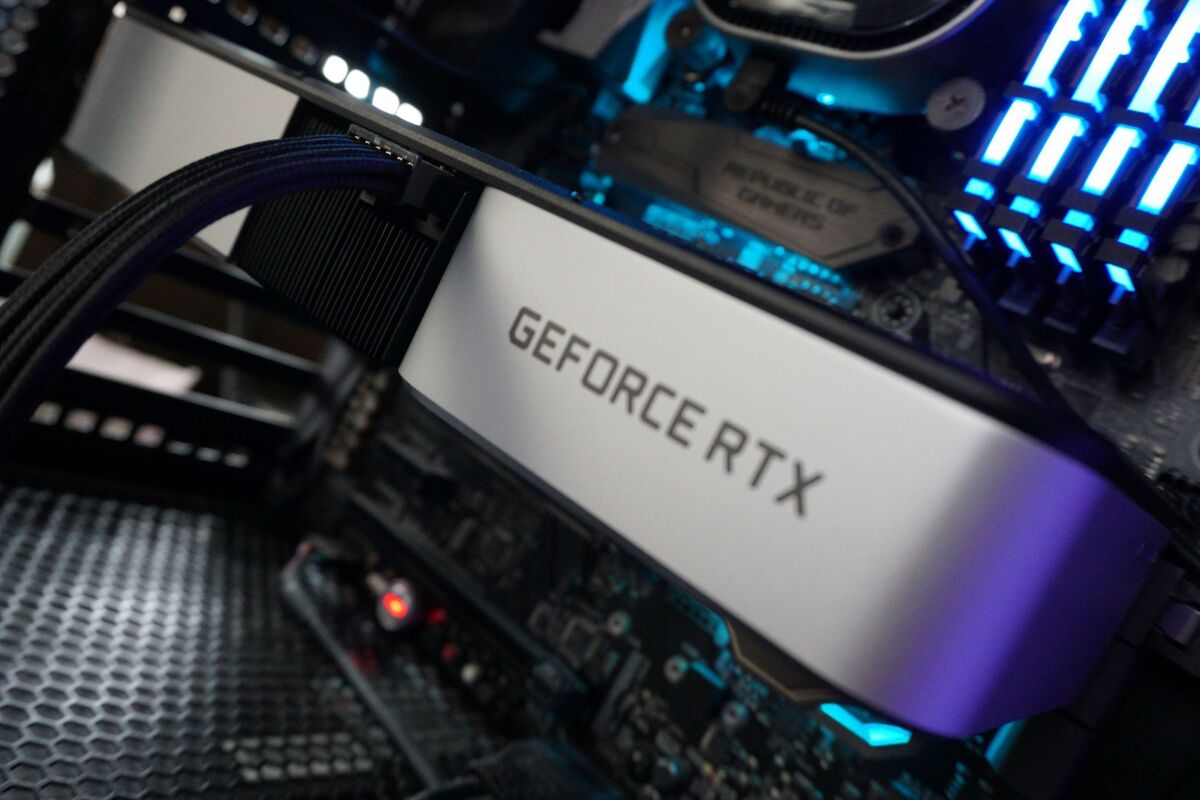 Brad Chacos/IDG
Brad Chacos/IDG
The GeForce RTX 3060 Ti in our test system.
We test a variety of games spanning various engines, genres, vendor sponsorships (Nvidia, AMD, and Intel), and graphics APIs (DirectX 11, DX12, and Vulkan). Each game is tested using its in-game benchmark at the highest possible graphics presets unless otherwise noted, with VSync, frame rate caps, real-time ray tracing or DLSS effects, and FreeSync/G-Sync disabled, along with any other vendor-specific technologies like FidelityFX tools or Nvidia Reflex. We’ve also enabled temporal anti-aliasing (TAA) to push these cards to their limits. We run each benchmark at least three times and list the average result for each test.
Nvidia’s claims prove true: The GeForce RTX 3060 Ti indeed winds up a hair faster than the last-gen RTX 2080 Super across the board—Wolfenstein Youngblood is the lone exception, and that gap is very close. The older RTX 2060 Founders Edition gets absolutely massacred by Nvidia’s new GPU. Given that, we’ll present these standard benchmarks without further commentary.
GeForce RTX 3060 Ti gaming benchmarks
Watch Dogs: Legion
Watch Dogs: Legion is one of the first games to debut on next-gen consoles. Ubisoft upgraded its Disrupt engine to include cutting-edge features like real-time ray tracing and Nvidia’s DLSS. We disable those effects for this testing, but Legion remains a strenuous game even on high-end hardware with its optional high-resolution texture pack installed. No card can maintain a 60-frames-per-second average with Ultra graphics options enabled, and the game allocates more than 8GB of memory even at 1440p. Oof.
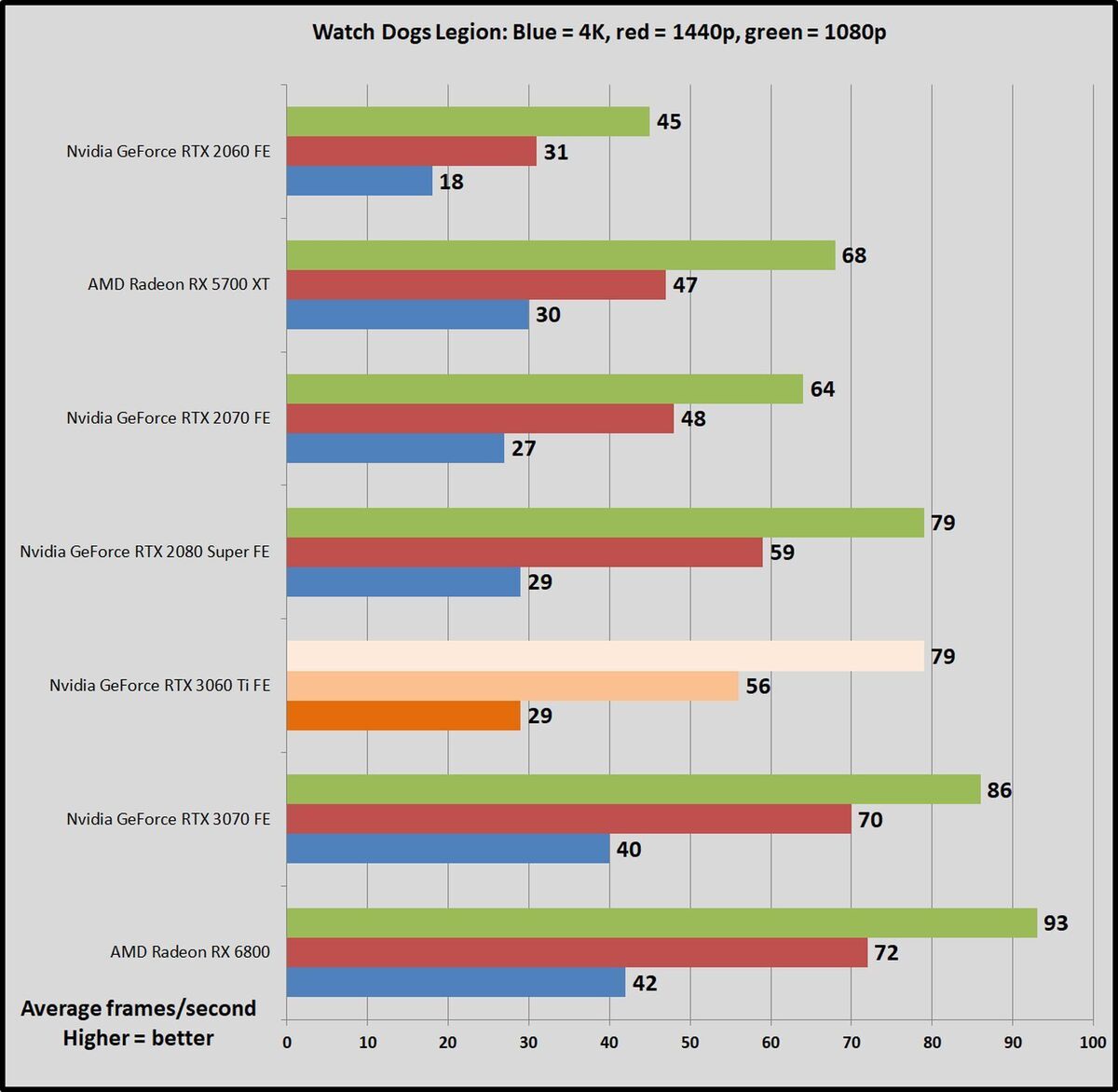 Brad Chacos/IDG
Brad Chacos/IDGHorizon Zero Dawn
Yep, PlayStation exclusives are coming to the PC now. Horizon Zero Dawn runs on Guerrilla Games’ Decima engine, the same engine that powers Death Stranding. Ambient Occlusion can offer iffy results if set to Ultra, so we test with that setting at Medium. Every other visual option is maxed out.
 Brad Chacos/IDG
Brad Chacos/IDGNext page: Gaming benchmarks continue
Page Break
Gears Tactics
Gears Tactics puts it own brutal, fast-paced spin on the XCOM-like genre. This Unreal Engine 4-powered game was built from the ground up for DirectX 12, and we love being able to work a tactics-style game into our benchmarking suite. Better yet, the game comes with a plethora of graphics options for PC snobs. More games should devote such loving care to explaining what flipping all these visual knobs mean.
You can’t use the presets to benchmark Gears Tactics, as it intelligently scales to work best on your installed hardware, meaning that “Ultra” on one graphics card can load different settings than “Ultra” on a weaker card. We manually set all options to their highest possible settings.
 Brad Chacos/IDG
Brad Chacos/IDGWolfenstein: Youngblood
Wolfenstein: Youngblood is more fun when you can play cooperatively with a buddy, but it’s a fearless experiment—and an absolute technical showcase. Running on the Vulkan API, Youngblood achieves blistering frame rates, and it supports all sorts of cutting-edge technologies like ray tracing, DLSS 2.0, HDR, GPU culling, asynchronous computing, and Nvidia’s Content Adaptive Shading. The game includes a built-in benchmark with two different scenes; we tested Lab X.
 Brad Chacos/IDG
Brad Chacos/IDGMetro Exodus
One of the best games of 2019, Metro Exodus is one of the best-looking games around, too. The latest version of the 4A Engine provides incredibly luscious, ultra-detailed visuals, with one of the most stunning real-time ray tracing implementations released yet. We test in DirectX 12 mode with ray tracing, Hairworks, and DLSS disabled for our basic benchmarks.
 Brad Chacos/IDG
Brad Chacos/IDGBorderlands 3
Borderlands is back! Gearbox’s game defaults to DX12, so we do as well. It gives us a glimpse at the ultra-popular Unreal Engine 4’s performance in a traditional shooter.
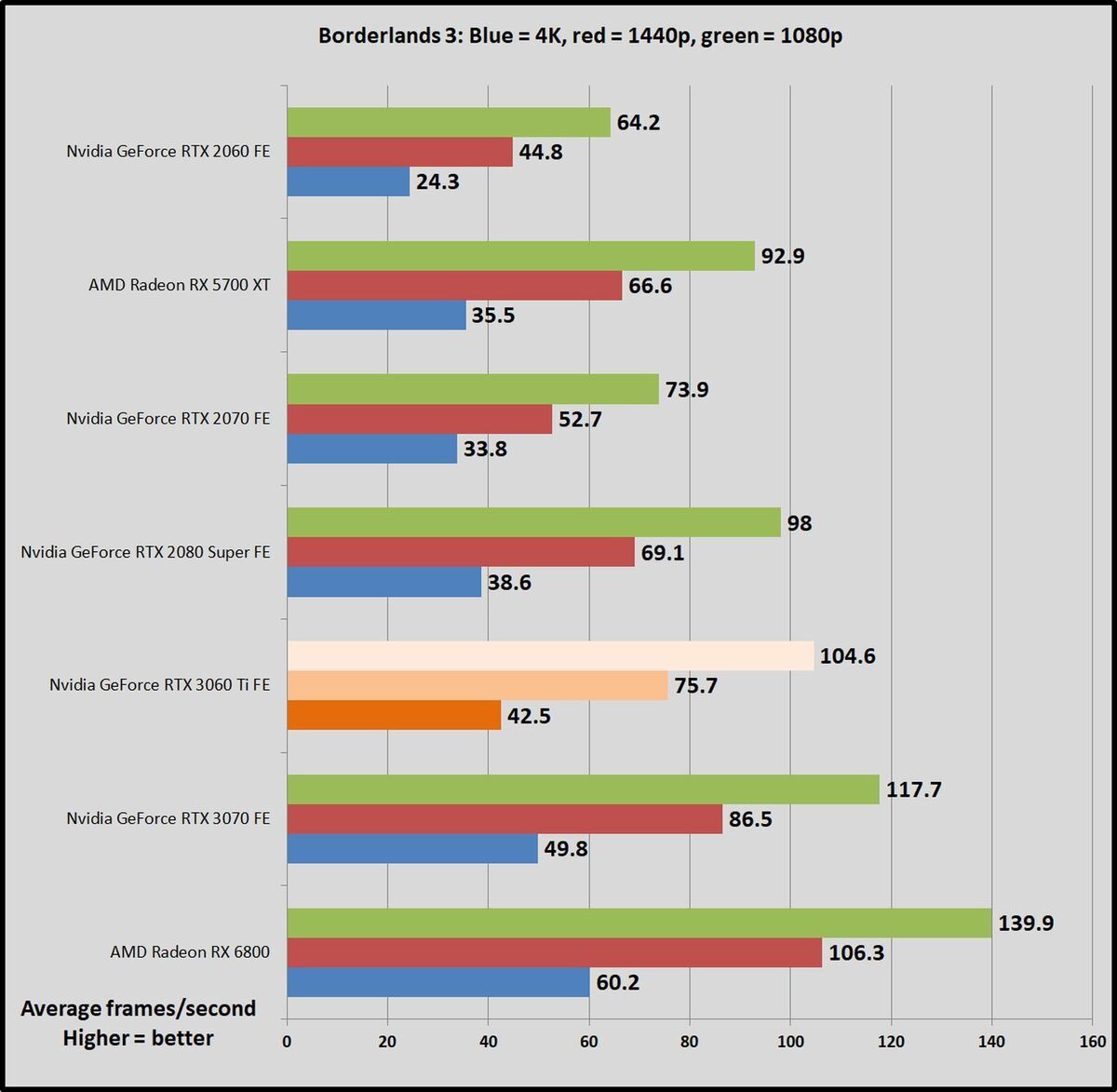 Brad Chacos/IDG
Brad Chacos/IDGStrange Brigade
Strange Brigade is a cooperative third-person shooter where a team of adventurers blasts through hordes of mythological enemies. It’s a technological showcase, built around the next-gen Vulkan and DirectX 12 technologies and infused with features like HDR support and the ability to toggle asynchronous compute on and off. It uses Rebellion’s custom Azure engine. We test using the Vulkan renderer, which is faster than DX12.
 Brad Chacos/IDG
Brad Chacos/IDGNext page: Gaming benchmark continue
Page Break
Total War: Troy
The latest game in the popular Total War saga, Troy was given away free for its first 24 hours on the Epic Games Store, moving over 7.5 million copies before it went on proper sale. Total War: Troy is built using a modified version of the Total War: Warhammer 2 engine, and this DX11 title looks stunning for a turn-based strategy game. We test the more intensive battle benchmark.
 Brad Chacos/IDG
Brad Chacos/IDGF1 2020
The latest in a long line of successful racing games, F1 2020 is a gem to test, supplying a wide array of both graphical and benchmarking options, making it a much more reliable (and fun) option that the Forza series. It’s built on the latest version of Codemasters’ buttery-smooth Ego game engine, complete with support for DX12 and Nvidia’s DLSS technology. We test two laps on the Australia course, with clear skies on and DLSS off.
 Brad Chacos/IDG
Brad Chacos/IDGShadow of the Tomb Raider
Shadow of the Tomb Raider concludes the reboot trilogy, and it’s utterly gorgeous. Square Enix optimized this game for DX12, and recommends DX11 only if you’re using older hardware or Windows 7, so we test with DX12. Shadow of the Tomb Raider uses an enhanced version of the Foundation engine that also powered Rise of the Tomb Raider and includes optional real-time ray tracing and DLSS features.
 Brad Chacos/IDG
Brad Chacos/IDGRainbow Six Siege
Like GTA V, Ubisoft’s Rainbow Six Siege still dominates the Steam charts years after its launch, and it’ll be getting a visual upgrade for the next-gen consoles. The developers have poured a ton of work into the game’s AnvilNext engine over the years, eventually rolling out a Vulkan version of the game that we use to test. By default, the game lowers the render scaling to increase frame rates, but we set it to 100 percent to benchmark native rendering performance on graphics cards. Even still, frame rates soar.
 Brad Chacos/IDG
Brad Chacos/IDGNext page: GeForce RTX 3060 Ti ray tracing benchmarks
Page Break
GeForce RTX 3060 Ti ray tracing benchmarks
While we were busy running benchmarks, we flipped on real-time ray tracing and Nvidia’s Deep Learning Super Sampling in a handful of games. Enabling ray tracing imparts a massive performance impact; DLSS’s AI-enhanced image upscaling claws a lot of those frames back. (DLSS can also be activated separately from ray tracing to drive your in-game frame rates beyond what Nvidia’s hardware pumps out natively.) We dove deeper into Ampere’s ray tracing and DLSS performance in our RTX 3080 review if you’re interested in more analysis.
We tested ray tracing capabilities set to Ultra in four games, each deploying a different version of the cutting-edge lighting technology. Shadow of the Tomb Raider uses (surprise!) ray-traced shadows; the ray-traced global illumination in Metro Exodus truly transforms the look and feel of that game; Wolfenstein Youngblood and Ubisoft’s strenuous Watch Dogs Legion show off ray-traced reflections on the rival Vulkan and DirectX 12 APIs, respectively. Tomb Raider and Metro use Nvidia’s original DLSS 1.0 implementation, while Wolfenstein and Watch Dogs deploy the faster, better DLSS 2.0.
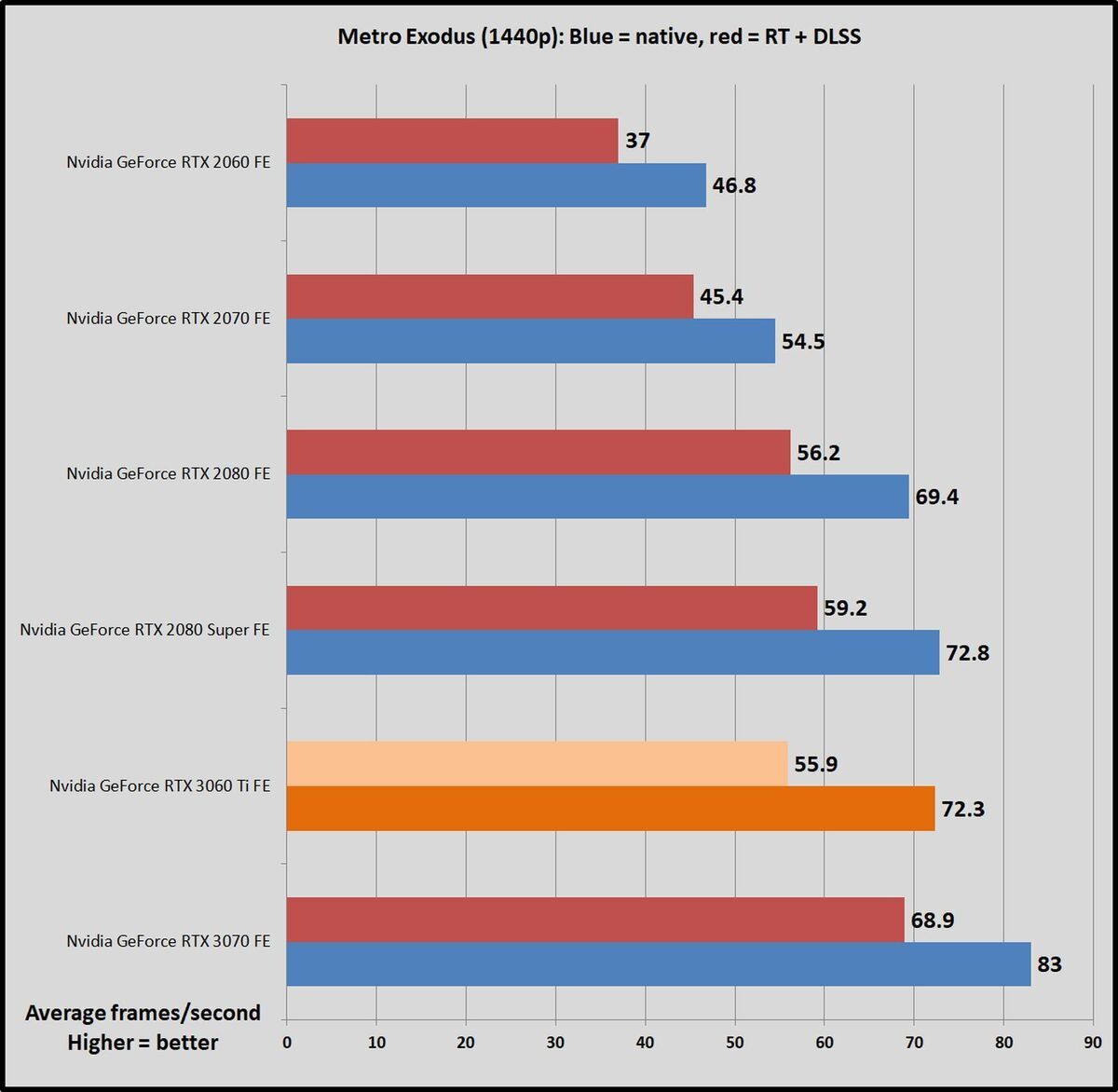 Brad Chacos/IDG
Brad Chacos/IDG Brad Chacos/IDG
Brad Chacos/IDG Brad Chacos/IDG
Brad Chacos/IDG Brad Chacos/IDG
Brad Chacos/IDGNo real surprises here. The GeForce RTX 3060 Ti is roughly as fast as the last-gen RTX 2080 Super in traditional gaming performance, and it’s roughly as fast in ray tracing performance too. The last-gen RTX 2060 FE couldn’t even run Wolfenstein with ray tracing enabled. We repeatedly received memory capacity warnings onscreen, then the game crashed.
Next page: Power, thermals, and noise
Page Break
Power draw, thermals, and noise
We test power draw by looping the F1 2020 benchmark at 4K for about 20 minutes after we’ve benchmarked everything else and noting the highest reading on our Watts Up Pro meter, which measures the power consumption of our entire test system. The initial part of the race, where all competing cars are onscreen simultaneously, tends to be the most demanding portion.
This isn’t a worst-case test; we removed the Core i7 8700K’s overclock and specifically chose a GPU-bound game running at a GPU-bound resolution to gauge performance when the graphics card is sweating hard. If you’re playing a game that also hammers the CPU, you could see higher overall system power draws. Consider yourself warned.
 Brad Chacos/IDG
Brad Chacos/IDGThe results prove that the Ampere GPU architecture in the RTX 30-series is more power-efficient than the Turing GPUs in last-generation’s RTX 20-series cards, but that the graphics cards themselves draw more power in the same class. The RTX 3060 Ti Founders Edition draws a significant 47 watts less under load than the RTX 2080 Super it topples in performance—a sterling result—but also draws over 40W more than the RTX 2060 Founders Edition. The new card smokes the older 60-class option in raw performance, though.
We test thermals by leaving GPU-Z open during the F1 2020 power draw test, noting the highest maximum temperature at the end.
 Brad Chacos/IDG
Brad Chacos/IDGNvidia’s radical new cooler continues to impress as it moves down the Founders Edition product stack. Maxing out at a mere 72 degrees under load is a fantastic result for a reference(ish) graphics card, and significantly cooler than the RTX 2080 Super achieved with similar performance levels. Yet it still leaves room for custom variants by partners like Asus, MSI, and EVGA to improve things—especially noise levels.
This is the same cooler design found on the RTX 3070 FE, meaning it not only delivers identical temperature performance, but also acoustic results. While the beefed-up version of the cooler on Nvidia’s more expensive $700 RTX 3080 FE was very quiet, the much smaller RTX 3060 Ti and 3070 Founders Edition models sounds like standard graphics cards--moderately loud.
Next page: Should you buy the GeForce RTX 3060 Ti?
Page Break
Should you buy the GeForce RTX 3060 Ti?
Absolutely—if you can find it in this extremely supply-limited, demand-heavy year. The $400 GeForce RTX 3060 Ti is a spectacular graphics card that delivers performance a hair faster than last-generation’s $800 RTX 2080 Super in both traditional and ray traced games for half the price, and with lower power consumption. Hot damn.
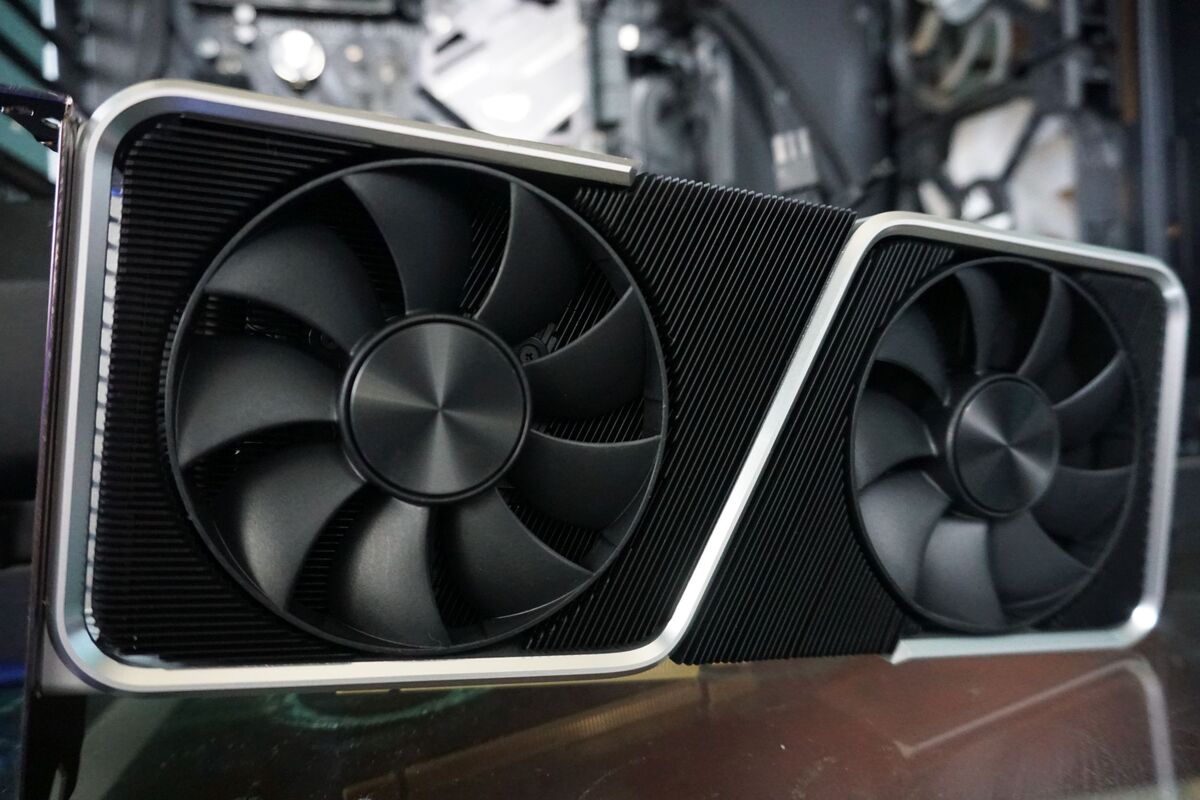 Brad Chacos/IDG
Brad Chacos/IDGThat performance paired with 8GB of GDDR6 memory makes the GeForce RTX 3060 Ti a fantastic 1440p gaming option. It exceeds the hallowed 60-frames-per-second mark in every game tested at that resolution, even with the most strenuous visual settings enabled. It flies well beyond that mark in several games, and it should have no problem holding 90 fps+ at 1440p in most titles if you don’t mind performing minor tuning on graphics options. The RTX 3060 Ti would also be a fine pairing for a high-refresh-rate 1080p monitor, though AMD’s inevitable counterpunch may prevail at those settings, given the Radeon RX 6800-series' superior performance at lower resolutions. Nvidia’s GPUs handle ray tracing much better than Radeon cards, however, and AMD has no answer to Nvidia’s fantastic DLSS tech.
You can even play games at 4K at a fine clip with this card if you bump graphics from Ultra to High in most games, as you could with the older RTX 2080 Super. The 8GB memory capacity likely won’t hold up well over the long term, however. We’d recommend opting for a graphics card with more VRAM if you’re buying for 4K today—either the AMD Radeon RX 6800-series or Nvidia’s GeForce RTX 3080. Those cards cost substantially more, though.
The step-up $500 GeForce RTX 3070 also comes with 8GB of GDDR6 memory, so it’s in the running if you’re looking for a 1440p graphics card. It’s only 9 percent to 15 percent faster than the RTX 3060 Ti at 1440p depending on the game, however, for 25 percent more cash. That makes the RTX 3060 Ti a better option for most people, though the RTX 2070’s performance boost may be worthwhile if you hold onto your graphics cards for an especially long time before upgrading again. The extra frames also make the RTX 3070 better for entry-level 4K gaming, though again, we’d be leery about its 8GB of VRAM at that capacity.
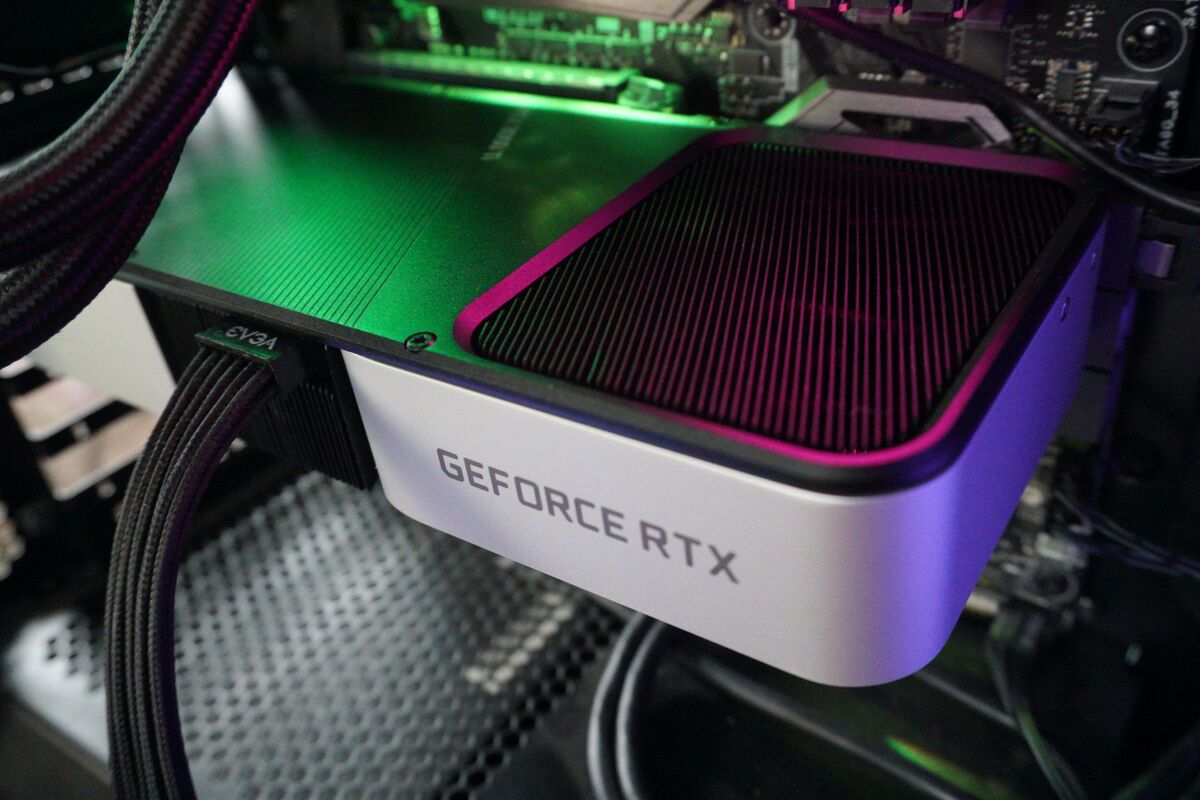 Brad Chacos/IDG
Brad Chacos/IDGAt $400, the GeForce RTX 3060 Ti immediately kills any remaining value proposition for comparable last-gen graphics cards like the Radeon RX 5700, 5700 XT, GeForce RTX 2060, and 2060 Super, unless you score one at a massive discount. Don’t count on seeing those discounts in today’s economy, though. Rather than splurging on older tech at this point, be patient and wait to get your hands on this GPU.
Nvidia’s unorthodox RTX 30-series Founders Edition cooling continues to impress, though less so the further we move down the stack. The GeForce RTX 3060 Ti FE’s 72-degree Celsius temperatures and soft, but audible noise levels don’t disappoint, especially for a card made by Nvidia itself, but there is room for partner cards from EVGA, Asus and others to improve things. (Stay tuned for many custom RTX 3060 Ti reviews in the coming days—we’ve already got several in our hands.) We still dislike the proprietary 12-pin power connector that Nvidia used with its Founders Edition cards this generation to squeeze in a smaller PCB. The company includes an adapter in the box, but that adapter is too short and looks chunky and ugly compared to nicer traditional cabling options.
Don’t let that dissuade you, though. Performance this fast cost twice as much last generation and landed near the top of the RTX 20-series stack. Getting this much eye candy for $400 is very welcome indeed. The GeForce RTX 3060 Ti is spectacular—a virtually flawless 1440p GPU, minor Founders Edition design squabbles aside. Here’s hoping stocks are plentiful and custom variants aren’t priced as extravagantly as the higher-up RTX 30-series options, because this GPU should sell like hotcakes.





